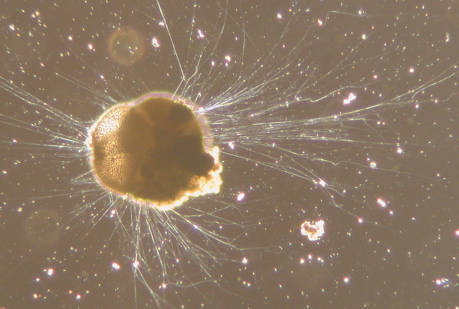
| Palaeos: |  |
Rhizaria |
| EUKARYA | Foraminifera |
| Page Back | Unit Back | Unit Home | References | Glossary | Pieces |
| Page Next | Unit Next | Eukarya | Dendrogram | Taxon Index | Time |
Rhizaria |--Radiolaria | |--Acantharia | `--Polycystinea `--+--+--Acetosporea | `--+--Xenophyophorea | `--Foraminifera `--+--Phytomyxea `--Cercozoa |
Introduction Biology Taxonomy Phylogeny References |
 Live Ammonia tepida benthic foraminiferan (Polythalamea >n; Rotaliida >n; Rotalioidea >n; Rotaliidae) collected from San Francisco Bay. Phase-contrast photomicrograph by Scott Fay, UC Berkeley, 2005. Wikipedia - Attribution Share Alike 2.5 license, image uploaded by Safay. |
Foraminifera are amoeboid protists (Kingdom Protista) that produce protective shells, also known as tests, which have openings or foramina for the extrusion of pseudopodia, from which the group derives its name. they are considered to comprise a taxonomic order, the Foraminiferida, within the rhizopod subclass Granuloreticulosa.
Some classifiers have given them higher taxonomic rank, as high as phylum, which results in crowding of kingdom level taxa, and have substituted the Retaria for the Granuloreticulosa. Ranking foraminifera lower than order results in generic crowding and the need for extra subgenera and subspecies.
The living organism, loosely referred to as an animal, is unicellular or acellular, but not in the real sense of the word, primitive. Complex body functions performed by differentiated tissue and distinct organs in Metazoa are performed within the cell itself. As with Amoebida, the protoplasm in Foraminiferida is divided into an inner layer of darkish endoplasm surrounded by an outer layer of lighter ectoplasm. Pseudopoda, which are formed from ectoplasm, are anastomosing - branching and recombining. Endoplasm is confined to already constructed chambers, which are formed from ectoplasm and pseudopoda, and may be colored in shades of yellow, yellowish brown, greenish brown, salmon-rose, orange-red, or crimson.
Nuclei All forams have one or more nuclei, which are typically spherical. Nuclei of the more primitive, agglutinated or pseudochitinous genera are inflexible, enclosed in a thick membrane. Nuclei of more evolved forms, especially those with numerous narrow foramina, are more plastic, with thinner membranes.
Reproduction cycles Forams go through an alternation of generations in which an asexual stage with simple multiple fission (schizogeny) is followed by a sexual stage in which gametes are produced (gamogeny), so on and so forth. During the asexual phase the entire protoplasm is used , the parent being termed schizont or agamont, Resulting embryos are comparatively large and produce large proloculi.
Gametes During the sexual phase of reproduction gametes are produced which combine in pairs to form new individuals in which proloculi are small. Most forms studied so far are hologamic which produce unequally biflagellate gametes. In a few genera such as Allogromia and plastogamic forms such as Patelina and Rubratella, relatively large (40µ - 50µ in diameter) amoeboid gametes are produced. Other plastogamic genera such as Glabrotella have triflagellate gametes about 8µ in diameter. Biflagellate gametes typically vary in length from 2µ - 6µ and in width from 1.2µ - 3.5µ, Flagella range in length from 3µ for the smaller and 8µ for the larger to 5µ for the smaller and 20µ for the larger.
Pseudopodia Pseudopodia (informally pseudopods or false feet) in foraminifera are invariably granuloreticulose; composed of very elongate extensions of the protoplasm which readily bifurcate and anastomose. Individual pseudopods are only slightly thicker than the plasmatic granules streaming within them. Commonly they have a more firm axis surround by a more fluid layer. The relatively more solid axis and granular streaming are the most characteristic features.
The most important function of the pseudopods is in the capturing and digesting of prey, and in the expelling of debris. Other functions are in the construction of tests, forming of protective cysts, and making temporary or semipermanent attachment to substrate.
References: Cushman 1950, Loeblich & Tappan 1988.
Recognized suborders from Loeblich & Tappan 1988, in more or less phylogenetic sequence:
The Carterinina, Robertinina, Lagenina, Globigerinina, and Spirillinina were removed form the Rotaliina in the Treatise on Invertebrate Paleontology Part C (Loeblich and Tappan 1964) where they were ranked as superfamilies; the Involutinina separated from the Cassidulinacea, the Silicoloculinina from the Litualacea (same).
John M 110328

Edit 04.04.10: Note that the majority of forams are actually the paraphyletic allogromiids, which, I am told, are to forams as protists are to eukaryotes.
References: Flakowski, 2005, Habura et al 2006, Longet & Pawlowski 2007, and Pawlowski 2003.
Psi Wavefunction, 100209 ToE Expansion pack: Foraminifera!
| Page Back | Page Top | Unit Home | Page Next |

